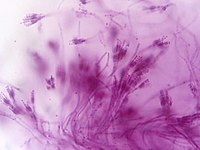Penicillium
Penicillium is a group, or a genus, of ascomycetous fungi commonly isolated from environments like soil, vegetation, and many food products. It is known to have ecological importance as a decomposer of organic material and cause rotting in food crops by mycotoxin production.[1] Other members of this group are known to produce penicillin’s, a molecule of commonly used antibiotics. Antibiotics kills or stops the growth of certain kinds of bacteria inside the body to reduce or stop infection of harmful bacteria. This genus of 354 species is widely impactful with many applications affecting every modern human today e.g., food and drug production.[2]
| Penicillium | |
|---|---|

| |
| Penicillium sp. | |
| Scientific classification | |
| Kingdom: | |
| Division: | Ascomycota
|
| Class: | Eurotiomycetes
|
| Order: | |
| Family: | Trichomaceae
|
| Genus: | Penicillium
|
Characteristics
changeThe mycelium is a highly branched network of multinucleate, usually colourless hyphae. The conidiospores are the main dispersal route of the fungi, and are often green in colour.
Sexual reproduction involves the production of ascospores. The asci contain eight unicellular ascospores each.
Ecology
changeSpecies of Penicillium are ubiquitous soil fungi preferring cool and moderate climates, commonly present wherever organic material is available. Saprophytic species of Penicillium and Aspergillus are among the best-known representatives of the Eurotiales. They live mainly on organic biodegradable substances. Commonly known as moulds, they are among the main causes of food spoilage.[3] Many species produce toxins which work against bacteria and other fungi. The ability of these Penicillium species to grow on seeds and other stored foods depends on their ability to thrive in low humidity and to colonize rapidly by aerial dispersion while the seeds are sufficiently moist.[4] Some species have a blue colour, commonly growing on old bread and giving it a blue fuzzy texture.
Select species
changePenicillium is a genus of fungi that includes:
- Penicillium chrysogenum (previously known as Penicillium notatum), which produces the antibiotic penicillin.
- Penicillium marneffei, a thermally dimorphic species endemic in Southeast Asia, which presents a threat of systemic infection to AIDS patients.
- Penicillium camemberti, which is used in the production of Camembert and Brie cheeses.
- Penicillium candida, which is used in making Brie and Camembert.
- Penicillium glaucum, which is used in making Gorgonzola cheese.
- Penicillium roqueforti, which is used in making Roquefort, Danish Blue cheese and also recently Gorgonzola.
References
change- ↑ Pitt, J. I.; Basílico, J. C.; Abarca, M. L.; López, C. (2000). "Mycotoxins and toxigenic fungi". Medical Mycology. 38 Suppl 1: 41–46. ISSN 1369-3786. PMID 11204163.
- ↑ Kirk PM; et al 2008. Dictionary of the Fungi. 10th ed, Wallingford, UK: CABI, p. 505. ISBN 978-0-85199-826-8
- ↑ Samson R.A; Seifert K.A. et al 2004. Phylogenetic analysis of Penicillium subgenus Pencillium using partial beta-tubulin sequences. Studies in Mycology 49: 175–200. [1] Archived 2012-03-22 at the Wayback Machine
- ↑ Pitt J.I. et al 2000. Mycotoxins and toxigenic fungi. Medical Mycology 38 (Suppl 1): 41–46. [2]